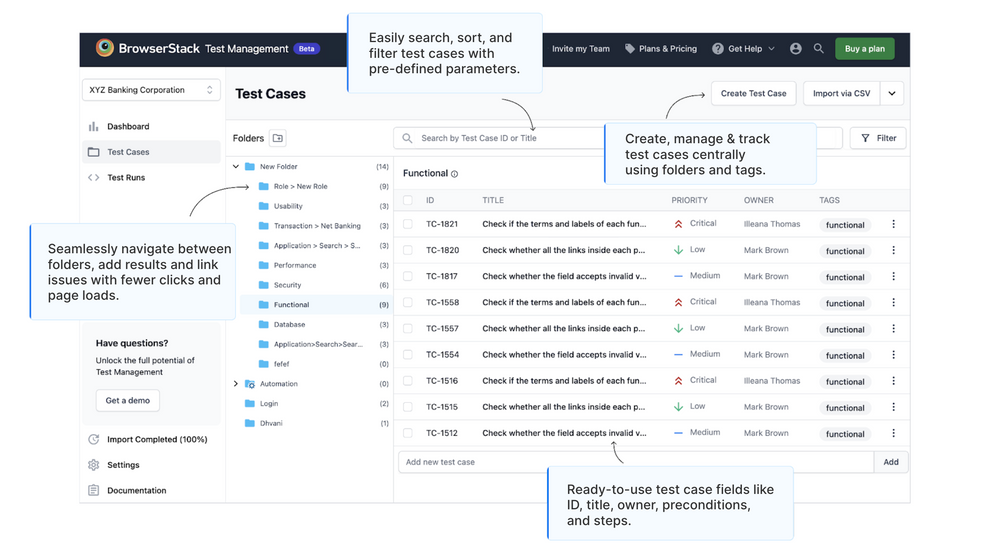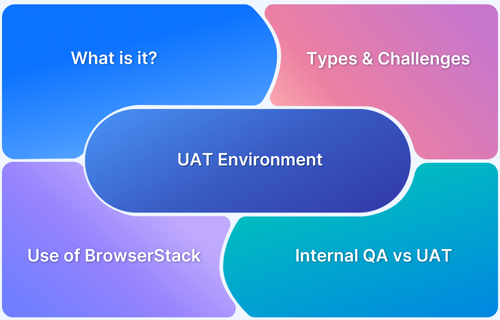Mastering UAT Test Scripts
By Gopal Kaushal, Community Contributor - December 26, 2024
User Acceptance Testing (UAT) is an important step in the software development life cycle. This process involves real users who will eventually use the software. They test whether it satisfies their requirements and operates in the manner expected in normal scenarios.
UAT is performed after system and integration testing. It checks whether the software is easy to use, meets business requirements, and works well at the end-user level. Its main goal is to catch problems and ensure a smooth software release.
This article dives deeper into understanding and developing UAT test scripts that ensure user-friendliness and software functionality.
- What are UAT Test Scripts?
- Importance of User Acceptance Testing Scripts
- Elements of a Good UAT Test Script
- Who Should Write a UAT script?
- Steps to Develop UAT Test Scripts
- Sample UAT Script Template
- Best Practices for Writing UAT Scripts
- Difference between Test Script and UAT Script
- How to do User Acceptance Testing with BrowserStack?
- Useful Resources for User Acceptance Testing
What are UAT Test Scripts?
UAT test scripts are detailed instructions designed to guide users through the testing process during UAT. The scripts describe the step-by-step actions that users need to take to test the software, covering a variety of scenarios and expected outcomes.
Each script is designed to test a specific function or characteristic of the software, ensuring it meets user requirements and functions as expected.
Importance of User Acceptance Testing Scripts
UAT test scripts are essential in testing software because they ensure it works precisely as the user expects. They provide a well-defined path to testing, making it easier to track results and identify issues.
These scripts ensure all users test the software under consistent conditions because everyone follows the same steps.
This ensures that well-written UAT test scripts minimise the chances of missing critical issues and ensure the final product is ready for release and meets business goals and user expectations.
Elements of a Good UAT Test Script
A good UAT test script is necessary for clear and structured testing. It gives a well-defined test case with ease of execution during the process. Hence, the core elements of a UAT test script help track progress, identify problems, and prove software functionality.
It has the following key components:
- Test Case ID: A unique identifier for each test case facilitates easy tracking and referencing throughout the test process.
- Test Case Description: Brief overview outlining the test case’s purpose, specific for testing any feature or functionality.
- Preconditions: States the conditions necessary before running the test, including specific user configurations or roles.
- Test Steps: This is the clear sequence of actions that the tester needs to perform to execute the test.
- Expected Results: The expected outcome of each testing phase helps determine whether the software is functioning as expected.
- Bugs: Issues or defects captured during the test are assigned with a reference number.
- Status: Indicates whether the test case has passed, failed, or needs further action.
- Comments: Additional remarks or observations that could present a background or explain unusual findings encountered in the experiment.
Also Read: Test Case Templates with Example
Who Should Write a UAT script?
While real users do UAT testing, the script they follow must be created by someone with deep testing knowledge. Generally, it is prepared by people who deeply understand the software’s intended use, such as business analysts, product managers, or end-users familiar with the system. They are best positioned to generate test cases that reflect real-world scenarios and ensure the software is delivered as per the business requirements. Collaboration between technical teams and end-users is also needed to achieve comprehensive test coverage.
Steps to Develop UAT Test Scripts
Developing an effective UAT test script is a systematic process for determining whether the software meets user expectations. Every phase, from analysing the requirements to executing test cases, ensures the software’s correctness.
Here is a step-by-step guide toward developing detailed UAT test scripts:
Requirement Analysis
First, review the business requirements, user stories, and system documentation to ensure that test scripts mirror the genuine needs of users. For instance, if the requirement is to allow users to change their passwords, the script will test the reset functionality under various conditions.
Determine Test Objectives
Explicitly define the objectives of each test case, which might be about functionality, performance, or use experience. The objective might be to confirm that users can log in without errors after entering the correct credentials.
Identify Scope
The scope of the UAT must also be clearly defined to ensure that features, processes, and scenarios that align with business processes are adequately tested. For example, where the software is a payment platform, critical processes such as payment processing, transaction history, and user profile management would come to the forefront.
Develop thorough test scenarios
Devise detailed step-by-step procedures for each test case. The statement of expected results should cover both positive and negative test cases. A positive test case could be a successful purchase by a user, while a negative test case can be a purchase when there is an inadequate balance in the account.
Also Read: Use Case vs Test Case: Core Differences
Add boundary and edge cases
Test under extreme conditions, such as accepting max-input limiting or unusual user behavior. This type of testing is crucial to ensure the system doesn’t fail under stress. For a text field, enter the maximum number of characters and special characters. Observe how the system handles them.
Review and Validate Test Cases
Distribute the test scripts to the relevant stakeholders, such as business analysts and end-users, for validation against business requirements. For instance, if a test script designed for submitting an online form lacks validation checks, it would require revision.
Also Read: Test Case Vs Test Script
Organise and prioritize test cases
Consolidate associated test cases based on test scenarios representing a real-world workflow or the user experience. An illustrative situation may encompass a user signing in, browsing available items, adding them to a shopping cart, and completing the purchase.
Prepare Test Data
Include actual and varied test data. Include a range of possible inputs to represent real user actions. For example, to test a search feature, use valid search terms, invalid keywords, and partial matches as test data.
Define Dependencies
Different prerequisites, dependencies, and data requirements must be mentioned and documented to successfully execute tests. Only then will the testers have all the information they need to execute the tests properly.
Use Version Control
As the software is upgraded and functionality varies, the UAT scripts must adapt to the changes to ensure that every possible scenario is tested accurately. Version control in UAT test scripts ensures the whole team works on the most recent versions, resulting in consistent and less confusing test scripts.
Sample UAT Script Template
A good UAT test script template will ensure consistency and clarity during testing. It can be used multiple times for different test cases, offering a clear framework to document all the necessary details.
Use this template by filling out below to reflect on all the information needed for various UAT tests.
1. Test Case Identification: Unique Identifier
2. Test Case Summary: A description of the test case
3. Prerequisites: [Prerequisites or configuration to be done before running the test case]
4. Test Procedures:
- Step 1 description
- Step 2 description
- Step 3 description
5. Expected Results:
- The expected result for Step 1.
- The expected answer for Step 2
- The expected result for Step 3.
6. Actual Results: [What Actually Happened in Testing]
7. Bugs: [Any defects/bugs encountered; where possible, reference numbers ]
8. Status: [Pass/Fail/Pending]
9. Remarks: [Additional observations or notes]
Best Practices for Writing UAT Scripts
Effective UAT scripts are the result of careful planning and thought. By following best practices, you ensure the scripts are clear, comprehensive, and aligned with business goals.
- Align with organizational Needs: Test scripts should be formulated with clear business objectives and user needs. This ensures that the software achieves the desired results.
- Keep it simple: Write test cases in nontechnical, straightforward language so readers unfamiliar with technology can easily understand them.
- Address All Possibilities: Include both positive and negative test cases to complete the software’s validation. Test how the system works with valid and invalid inputs. Include boundary and edge cases to test that the system performs well in extraordinary conditions, too.
- Be Specific and Detailed: Give the testing steps, such as what input to use and how to check for when the results come out. The more specific, the better.
- Focus on Real-World Scenarios: Ensure that test cases mimic real user behavior and actual business processes, reflecting how users will interact with the system.
- Keep tests independent: Every test case should be self-contained. Refrain from dependencies on test cases to allow them to be executed independently.
- State Clear Expected Results: Specify the anticipated results for each test phase. This facilitates testers’ promptly determining the test’s success or failure.
- Verification and Evaluation: Have business users and stakeholders review test scripts to reflect business requirements and real-world scenarios.
- Monitor and update regularly: Evaluate and upgrade test scripts based on feedback, new requirements, or changes in the software while ensuring they continue to be relevant and accurate.
Difference between Test Script and UAT Script
The following table outlines key differences between test case script and UAT script:
| Aspect | Test Case Script | UAT Script |
|---|---|---|
| Purpose | Validates the functionality of a software feature. | Ensures the software meets user and business requirements. |
| Target Audience | Written for developers and testers. | Written for end-users or business stakeholders. |
| Focus | Technical functionality, system behaviour, and integration. | Usability, real-world scenarios, and user experience. |
| Detail Level | Highly detailed, focusing on system-level testing. | Less technical, focusing on business processes and user tasks. |
| Test Environment | Typically conducted in a controlled development environment. | Conducted in a pre-production or user environment. |
| Scope | Focuses on testing specific features or functions. | Covers broader workflows, ensuring end-to-end business processes work. |
| Test Steps | Detailed steps focusing on system interactions. | Steps based on user actions and expected outcomes. |
| Expected Results | System-oriented results based on technical specifications. | Results based on business requirements and user expectations. |
| Execution | Executed by QA testers or developers. | Executed by actual end-users or business representatives. |
| Reporting | Focuses on bugs, defects, and system errors. | Focuses on user satisfaction, functionality, and business objectives. |
How to do User Acceptance Testing with BrowserStack?
BrowserStack’s Test Management tool makes mastering UAT test scripts by solving key challenges and providing efficiency. It allows real-world testing with access to the actual devices and browsers under which the scripts are verified.
The platform supports smooth collaboration, centralizes test case management, and integrates with CI/CD pipelines for automated script validation. It provides detailed analytics and reports to refine scripts so no stone is left unturned.
Here is how to do User Acceptance Testing through BrowserStack:
- Define UAT Objectives and Criteria: To guide the testing process effectively, set clear acceptance criteria aligned with business needs and user expectations.
- Develop and Prioritize Test Cases: Use BrowserStack Test Management to create test cases reflecting real-world user actions. Group them into test suites by priority, focusing on business-critical processes first.
- Configure Testing Environments: Select devices and browsers from BrowserStack’s library to simulate realistic environments. Adjust network settings or include real user data as needed.
- Execute Test Cases: Run test cases manually or automate them using BrowserStack. Track progress in real-time through the platform’s dashboards for streamlined management.
- Evaluate and Review Results: Analyze results using BrowserStack’s reporting tools. Gather feedback on usability and functionality to pinpoint areas for improvement.
- Resolve Issues and Re-Test: Collaborate with developers to fix defects. Re-test the software after applying fixes to ensure all acceptance criteria are met.
- Final Approval and Deployment: Ensure all major issues are resolved and gain stakeholder approval. Use insights from testing to finalize the product for deployment.
Conclusion
UAT test script is important for ensuring that software meets user expectations and business needs. With a systematic approach for defining test cases including real-world scenarios and actionable results, your software can be effectively validated before the release.
UAT test scripts identify problems early, leading to better user satisfaction and a smoother release. With the best practices and powerful tools, such as BrowserStack, teams can speed up the UAT process to deliver quality software that users approve.





